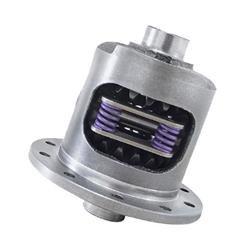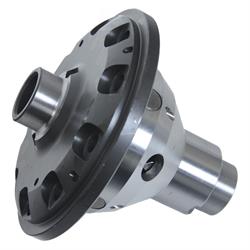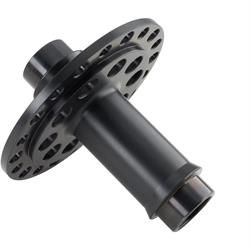What Is Positraction and Do You Need It?
No One Wants to Be Guilty of The One Wheel Peel
As horsepower goes up traction becomes that much more important. Keeping your hot rod, muscle car, or classic truck pointed in the right direction when your right foot is on the go pedal means having both rear tires (with the widest contact patch available) getting equal amounts of your engine’s output. The only way to do that is with a differential that has the ability to do so, such as a limited slip or “posi” style unit. Traditional open differentials cannot, which is why they are not only frowned upon for performance applications, but they are the giver of the infamous “one wheel peel” or “one tire fire,” as enthusiasts call them, about just one wheel getting all the engine’s output when attempting a burnout.
What Is Positraction?
There are several distinct types of differentials, both OEM and aftermarket, which can be considered a “posi” unit, though GM gets the credit for coining the proper “Positraction” brand starting in 1957 with their posi trac rear end Chevy. It was a designation that referred to the limited slip rear end being used in place of the standard open differential. Many of GM’s “Super Sport” or “SS” trim levels included Positraction differentials as part of the package. Today, the term Positraction, or posi, is used in the same manner that Kleenex is used when asking for a facial tissue. It is a brand name that has simply become a generic term for the type of product.
We’ll get into the meat of what a Positraction differential is below, but know that all OEM applications, no matter their unique branding, allow maximum traction while providing relatively quiet and reliable operation for street use. While some extreme applications in the muscle car heyday used optional locking or ratcheting differentials, it was a rarity to find a locker in a production rear axle. You may have heard the term “spool” thrown around in rear axle conversations as well. Spools are reserved for straight line dragstrip style action, as they essentially lock the left and right axles together with no differential action allowed for turning. We’ll cover all these options in depth in a future Toolbox guide.
Is Limited Slip the Same as Positraction?
In a simple answer, yes, they are essentially the same. As mentioned above, Positraction is a General Motors product name that, over the years has been shortened to “posi” and used as an overall performance term for a limited slip differential design. No matter if it is a mechanical design (uses clutch discs or a cone clutch), helical gear design, or other style of limited slip, the general automotive enthusiast public generally refers to them as posi units. Ironically, GM stopped using the Positraction name in the 1980s and today the option is now referred to as a Limited Slip differential. Go figure!
What Are the Benefits of Limited Slip Differential?
While your mind might immediately go to “burnouts!” for the answer to that question, it is indeed much more than being able to lay two glorious black strips of rubber down via excessive use of the throttle at your beck and call. But that is fun! No, the honest answer lies much more in providing better traction in driving environments where traction is often limited, such as wet roads, loose gravel, or dirt, and so forth, and yes even snow and ice if your car sees winter driving duties.
A limited slip differential (LSD) provides increased traction to the vehicle, which in turn offers more control and stability for the driver in traction-limited scenarios. Fitting a vehicle with a posie rear end or LSD means being able to make it through wet roads, loose dirt, and more without getting stuck, or the vehicle wanting to rotate. With a standard or open differential any high slip surface causes the wheel on that surface to take all the engine’s output and spin at a high rate, while the other wheel receives little to no power.
Additionally, the limited slip posi rear end setup provides the ability to slip a small amount so that the inside and outside wheels can rotate at different speeds around corners, something that a locker can do, but with a lot of ratcheting noise and driveline “upset.” A spool cannot slip at all internally (the “slip” comes from the inside tire chirping/skipping on the road surface as it is forced to spin as fast as the outside tire) and can be detrimental on the street. So, as you can see, the LSD or posi style differential carrier is the best bet for a performance street application.
How Does a Posi Rear End Work?
The most common rear end posi design is a mechanical one that uses alternating friction clutch discs and steel plates. The friction discs are splined to the differential’s side gears, while the steel plates are tabbed to the differential housing itself. The side gears are then tensioned by a preload spring or springs. To allow the left and right axles (and thus the tires) to have different rotation rates for turning and going around corners some slippage is allowed between the clutch plates and discs.
Under high load input the engine’s torque is applied through the spider gears to the side gears. Due to gear separation forces the side gears are pushed outward compressing the clutch discs and plates together and locking the side gears to the differential case, transmitting the engine’s torque to both wheels equally, no matter what surface the tires are on. A clutch style “posi” is a simple and effective solution that is still in use today in production vehicles. You may hear it called many things when bench racing with enthusiasts depending upon brand loyalty, including Sure-Grip (Mopar), Traction-Lok (Ford), Safe-T-Track (Pontiac), and of course Positraction (Chevrolet). Whatever the OEM called it originally it is a safe bet that today it is simply just called a “posi” rear by most enthusiasts.
How To Tell If You Have a Posi Rear End
The best way to determine if your vehicle has a posi-style differential installed is to remove the axle housing inspection cover on integral carrier design axles (GM 10 and 12 bolt, Ford 8.8-inch, etc.) or remove the center section on non-integral carrier rears (Ford 8-inch, Ford 9-inch, etc.) to perform a visual inspection that will confirm not only the presence of a posi-style rear, but what type of posi it may be as well. This will require draining the gear oil and removing the axles in some cases but is truly the best way to know for sure what is in there. A dead giveaway of posi track rear ends are the side gears supported by a preload spring (or springs).
Many enthusiasts will jack up the rear of their car (or potential purchase) to spin the wheels to confirm a posi unit. This is accomplished either in gear (Park for an auto) or in neutral. In gear/Park a rear end posi will not allow the wheels to rotate, while in neutral the wheels should rotate in the same direction. Generally, if the wheels rotate in opposite directions with the trans in gear/Park or in neutral then it is an open differential. That said, a severely worn clutch-style limited slip axle can act like an open differential when tested in this manner, which is why if there is any doubt opening the rear for visual confirmation is best. Lastly, do not rely on factory markings/tags either. Metal tags with “locker” or “limited slip” ID codes can be transferred during a rebuild or added to make the buyer think they are getting a factory LSD.
Can You Convert an Open Differential to A Limited Slip?
While there are a select few options that will convert your open differential carrier to a locker style, the reality of it is that to have an LSD or rear end posi functionality you will need to completely replace your open differential carrier with a posi traction differential kit. The labor involved to do so requires complete disassembly of the axle housing, including removal of the ring gear and carrier bearings. As such, it is often recommended to replace all carrier bearings, and it is the perfect time for upgrading the axle ratio as well, since most open carriers are usually fitted with low performance gears in the 2.XX range. Upgrading your differential to a steeper 3.73 posi rear end (or higher numerically rear gears) will really make your ride come alive!
Integral carrier axles often require the work to be performed in the car unless you’re willing to remove the complete axle housing and bring it to your favorite driveline shop. Rear axles that use non-integral setups, like the Ford 9-inch, allow you to easily pull the differential housing (center section, pig, chunk, third member, etc.), which can easily be transferred or even shipped to a driveline shop for upgrades. Of course, these rears also allow you to buy a completely built third member with the Ford 9-inch posi differential, gears, and more of your choice ready to bolt in as well. This is a terrific way to have your Ford 9-inch posi with a couple of different gear ratios available simply by swapping out the center section to allow the best gear ratio for your needs.
Do Limited Slip Differentials Make Noise?
One of the main benefits of the LSD or posie rear end is that they are much quieter than a locker-style differential. This has allowed the posi differential to become a popular option in the 1960s and more recently as a standard feature of pretty much every modern rear wheel drive V8 performance car since the late 1980s. That does not mean that they are completely silent however, after all a differential is a mechanical device filled with gears!
The most common noise in posi track rear ends will be clutch chatter when turning. As the clutch discs and steel plates fight the grip between the two and the gear oil used to lubricate and keep the differential cool. A friction modifier is an additive that is often used to provide more “slip” to the gear oil to reduce the chatter issue in LSD units that use clutch material. Not all gear oils will require friction modifier (check your gear oil to see if it is pre-mixed) and know that there is no hard and fast rule on how much to add to your differential. There are variables, including gear oil weight, condition of the clutches, spring tension on the side gears, vehicle weight, tire contact patch/traction rating, and more. The best solution is to add a small amount of friction modifier to your differential and drive it. If the chatter is still evident, add a bit more. You don’t want to add too much though and reduce the effectiveness of the limited slip’s clutches.






